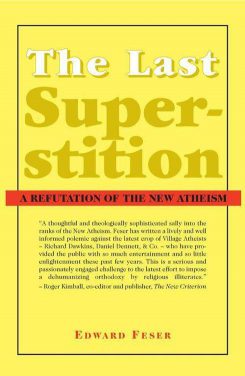The Last Superstition: Skip Ahead
Chapter 1
This chapter can safely be skipped. It’s equal parts complaining about The New Atheists and insulting them, making big claims, and giving Aristotle and Aquinas loving tongue-baths. He yearns for the good old days when people kept their atheism to themselves.
In this introductory chapter, Feser makes a number of big promises for what’s to come. That God exists, and that he can demonstrate this. That only under classical philosophy do reason and morality even make sense.
Perhaps the most striking thing is that, although the book is ostensibly addressed at the claims of New Atheism, and that the book is even subtitled “A Refutation of the New Atheism”, Feser is remarkably reluctant to address New Atheists’ claims, instead preferring to steer the conversation toward his favorite subjects, Plato, Aristotle, and Aquinas.
It’s not that that’s not a worthy topic of discussion. It’s just that Plato’s forms didn’t bring down the World Trade Center. It wasn’t Alvin Plantinga who accused Hillary Clinton of being in league with Lucifer from the podium of the 2016 Republican Convention. The average member of Joel Osteen’s congregation is as ignorant of Sophisticated Theology as the atheists he criticizes; perhaps more so.
(Update: some time after I wrote this, the pope wrote the following:
The Lord has entrusted the Archangels with the task of defending humanity.
— Pope Francis (@Pontifex) September 29, 2016
So from where I’m standing, Sophisticated Theology often looks fairly similar to the “unsophisticated” beliefs of ordinary theists.)
Harris opens The End of Faith with an Islamic suicide bombing. Page 1 of The God Delusion mentions 9/11, 7/7, the Crusades, persecution of Jews, the “troubles” of Northern Ireland, and more. Hitchens’s god is not Great opens (again, page 1) with a schoolteacher who thought, for religious reasons, that green plants were made for human eyes rather than the other way around. Dennett poses the question of whether behaviors like fasting for Ramadan are a good thing, all things considered. Atheism, new or old, has never been a purely academic affair, but rather rooted in the real world.
But Feser never deals with this. Tellingly, even in the section “The New Atheism”, he neither defines the term “New Atheism”, nor quotes any New Atheists.
More importantly, he fails to recognize that people – theists – do make the stupid claims he criticizes the New Atheists for focusing on. If the hoi polloi are still making stupid arguments seven centuries after Aquinas, then the fault for this failure of education can scarcely be laid at the feet of a movement that only began in earnest in 2001. (In fairness, he does address this in his talk, What We Owe the New Atheists, but it would have been nice if he’d included his response to New Atheist claims in his A Refutation of the New Atheism.)
Feser’s tone
To say that Feser’s tone is polemical would be an understatement:
a man who is irreligious, and especially a man who is positively hostile to religion, is (again, all things being equal) for that very reason and to that extent a bad man, and an irrational man. [p.14]
and
speaking with secularists themselves (there are no greater vulgarians) [p.14]
Those two come from the same paragraph, by the way.
Not to put too fine a point on it, they [secular readers] ought – literally – to get down on their knees and worship the God who mercifully sustains them in being at every instant, even as they foolishly scoff at Him. This is not only an act of faith, rightly understood; it is the highest manifestation and fulfillment, in this life anyway, of human reason itself. [p.26]
I’ve picked a few examples from Chapter 1, but this sort of thing permeates the book. I wanted to get this out of the way now in hopes of not dwelling too much on it later. But don’t take my word for it. See this friendly review, one that Feser has linked to, for examples.
He justifies his tone by claiming that it’ll improve the appeal of his book, and saying that the New Atheists did it first (p.25):
As the reader has no doubt already figured out, this book will also be as polemical as it is philosophical, though hardly more so than the books written by the “New Atheists” to whom I am responding. I believe this tone is appropriate, indeed necessary, for the New Atheism derives whatever influence it has far more from its rhetorical force and “sex appeal” (as I have called it) than from its very thin intellectual content. It is essential, then, not only that its intellectual pretensions are exposed but that its rhetoric is met with equal and opposite force.
Unfortunately, as I’ve said earlier, Feser rarely quotes the people he claims to be responding to, so it’s hard to tell what the New Atheists have written that’s so incendiary. I suspect that it’s things like what Chris Hallquist has called Dawkins’s Big Bad Quote about the God of the Old Testament, but since Feser doesn’t say, I can’t know for sure.
This constant vituperation undermines Feser’s overall goal: for one thing, it makes it easy to write him off as an angry crank. But more importantly, it hurts his ability to use the Courtier’s Reply: discussions with people who appeal to Sophisticated Theology often go like this:
Theist:<Argument A> therefore God exists.
Atheist: That argument is flawed, because of <X, Y, and Z>
Theist: You’re attacking a caricature. I gave you a quick summary of <argument A>, but in order to understand the full context, you really need to read books <B, C, D, …>
In this case, however, Feser wasn’t constrained by the limitations of some social media site. He decided that he could make his case in 300 pages, and still have plenty of space left over for insults. So if his summary of his, or Plato’s, or Aquinas’s arguments is too short, then the fault is his.


